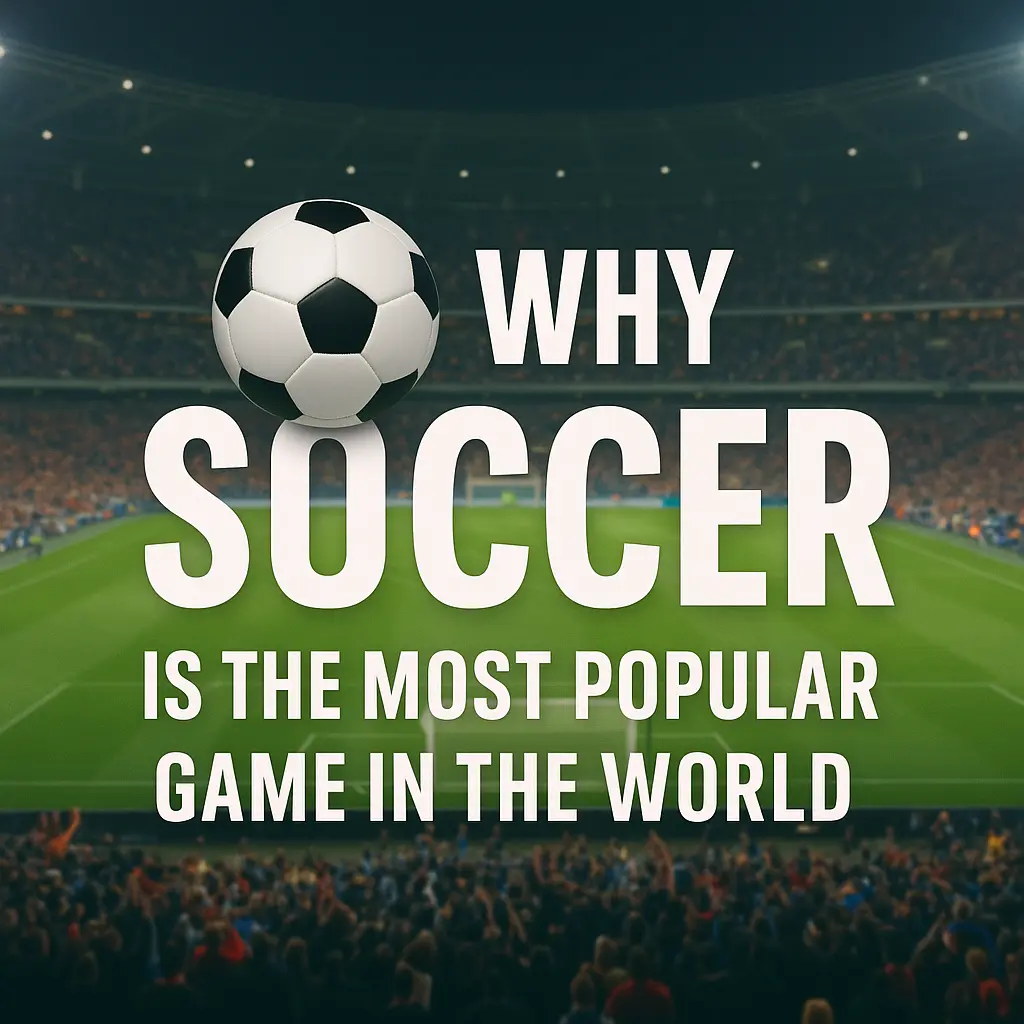The football is used globally, while in North America, it is called soccer., is the most beloved sport on the planet, with around 4 billion fans cheering it on. Its impact crosses geographical, cultural, and linguistic lines, serving as a unifying force for people from all walks of life. The FIFA World Cup, which takes place every four years, captures the attention of billions, often surpassing the Olympics in viewer engagement.
This article from Happy Birthday Wishes SMS explores the key reasons behind soccer’s worldwide charm, emphasizing its accessibility, simplicity, cultural importance, and emotional ties, while also reflecting on its historical background and modern-day influence.

Why Football Is the Most Popular Sport
Accessibility: A Game for Everyone
One of the primary reasons soccer is the most popular game globally is its accessibility. Unlike many sports that require specialized equipment, facilities, or training, soccer demands very little. At its core, all you need is a ball—or something resembling one—and a space to play. As noted in a post on X, “Soccer is the world’s most popular sport in large part because all you need is a ball” . Whether it’s a leather soccer ball, a plastic bottle, or a bundle of rags, players can improvise. Two objects, such as rocks or sticks, can mark goalposts, and the game is ready to begin.
This low barrier to entry makes soccer a universal playground game, particularly for children. In schoolyards, parks, and streets worldwide, kids chase balls in impromptu matches, requiring no formal training or expensive gear. Compared to sports like hockey, which demands costly equipment and ice rinks, or American football, which requires helmets and pads, soccer’s minimal requirements make it accessible to people of all socioeconomic backgrounds. A source from Forza Italian Football emphasizes, “You do not need a soccer ball to engage in the sport. You can even choose to kick a can around, and you will be enjoying football” . This accessibility ensures soccer’s presence in every corner of the globe, from urban slums to affluent suburbs.
Moreover, soccer’s adaptability to different environments enhances its appeal. It can be played on grass, dirt, sand, or concrete, in fields, streets, or beaches. Variants like street football, beach soccer, and futsal (indoor five-a-side) demonstrate its versatility. The Fédération Internationale de Football Association (FIFA) estimates that at the turn of the 21st century, over 1.3 billion people were “interested” in soccer, with millions actively participating in these varied formats (Britannica, 2025). This adaptability ensures that soccer remains a staple in playgrounds and communities, regardless of resources or infrastructure.
Simplicity: Easy to Learn, Hard to Master
Soccer’s rules are remarkably straightforward, contributing significantly to its popularity. The objective is simple: score more goals than your opponent by kicking the ball into their net, using any part of the body except the hands (except for the goalkeeper within the penalty area). A standard match lasts 90 minutes, split into two 45-minute halves, with 11 players per team. As Master Soccer Mind notes, “The basics of soccer are simple: You have 90 minutes to make the ball go into the opponent’s goal as many times as you can, and you aren’t allowed to use your hands. Simple, no complications, a goal is worth one point” .
This simplicity makes soccer accessible to newcomers. A child or beginner can grasp the core rules within minutes and start playing, unlike sports with complex scoring systems, such as American football (with touchdowns, field goals, and extra points) or cricket (with its intricate batting and bowling rules). Yet, while soccer is easy to learn, it offers immense depth for mastery. Skills like dribbling, passing, and shooting require years of practice, and tactical strategies—such as formations and pressing—add layers of complexity for competitive play. This balance of simplicity and depth ensures that soccer appeals to both casual playground players and professional athletes.
The simplicity also fosters inclusivity across ages, genders, and skill levels. Women’s soccer, for instance, has grown exponentially since the 1990s, with the U.S. women’s national team winning back-to-back World Cups, highlighting the sport’s universal appeal . Playground games often feature mixed groups, where kids of varying abilities can participate meaningfully, whether as a striker, defender, or goalkeeper. This inclusivity ensures that everyone can contribute, making soccer a communal experience.
Cultural Significance: A Global Unifier
Soccer transcends borders, languages, and cultures, acting as a global unifier. It’s often called “The Beautiful Game,” a term popularized by Pelé, capturing its ability to bring people together. From the favelas of Brazil to the villages of Africa, soccer is a shared language. Major tournaments like the FIFA World Cup, which drew an estimated 5 billion viewers in 2022, including 1.5 billion for the final alone, showcase its global reach . No other sporting event comes close to this viewership, with the World Cup’s quadrennial nature amplifying its cultural significance.
The 2023 Women’s World Cup broke records with 2 billion viewers, proving that soccer’s appeal is gender-inclusive. Stars like Alex Morgan, Sam Kerr, and Megan Rapinoe inspire millions of young girls.
Soccer’s ability to “paralyze entire cities and countries for one single game” underscores its emotional grip (Master Soccer Mind, 2018). In countries like Brazil, Argentina, and England, match days are akin to national holidays, with communities gathering in homes, bars, or public squares to watch. Rivalries, such as Barcelona vs. Real Madrid or Manchester United vs. Liverpool, fuel passionate fanbases, some with histories spanning over a century . These rivalries add drama and loyalty, making soccer a cultural cornerstone.
These clubs have passionate fanbases that span continents. Additionally, star players like Lionel Messi, Cristiano Ronaldo, Neymar Jr., and Kylian Mbappé are global celebrities, influencing fashion, culture, and social media. Their skills and personalities attract millions to the sport and inspire young athletes worldwide.
The sport’s global spread is also tied to its historical roots. Originating from ancient ball games like cuju in China (3000 BC) and evolving through medieval Europe, soccer was formalized in England in the 19th century with the establishment of the Football Association (Grasshopper Soccer). Its spread through British colonialism and trade routes embedded it in South America, Africa, and Asia, where local cultures adapted and embraced it. Today, FIFA’s 205 member associations and over 300,000 clubs reflect this global network (Library of Congress, 2023).
Economic Influence and Commercial Power
A Multi-Billion Dollar Industry
Soccer generates over $30 billion annually through:
TV rights (EPL earns ~$4 billion/year from broadcasting).
Sponsorships (Nike, Adidas, and Puma invest heavily).
Player transfers (Neymar’s €222M move to PSG in 2017 remains a record).
Grassroots to Superstars
Unlike many sports where talent development is restricted to wealthy nations, soccer offers a path out of poverty for players from:
Brazil’s favelas (Pele, Neymar, Vinicius Jr.)
African townships (Sadio Mané, Mohamed Salah)
Argentinian barrios (Lionel Messi, Diego Maradona)
The dream of becoming a professional footballer drives millions of kids worldwide.
Emotional Resonance: Passion and Drama
Soccer’s emotional intensity is a key driver of its popularity. A 90-minute match is a rollercoaster of excitement, tension, and drama, whether a team is dominating or fighting to equalize. Fans live and breathe every moment, from last-minute goals to penalty shootouts. As KU Sports notes, “A 90-minute match is a mixture of excitement, and drama – whether your team is winning or losing” (KU Sports, 2023). This emotional investment is evident in the chants, songs, and celebrations that fill stadiums and playgrounds alike.
The sport’s fan culture is unparalleled. Supporters sing anthems, wave flags, and even play instruments during matches, creating an electric atmosphere (Football Ground Map, 2021). On X, users highlight this passion: “It’s no secret that football has a huge fan following. What makes this sport so popular is the passion and dedication fans have” (@hvgoenka, 2019). This loyalty extends to playground games, where kids emulate their favorite players, like Lionel Messi or Cristiano Ronaldo, fueling their love for the game.
Soccer also offers moments of individual brilliance. A single player, regardless of size or strength, can change a game with a skillful dribble or a stunning goal. Unlike sports where physical attributes like height dominate (e.g., basketball), soccer rewards skill and creativity. Forza Italian Football points out, “A football player’s body size does not have a high significance regarding their performance. Even the scrawniest player can outperform others since the game is all about skill” (Forza Italian Football, 2021). This inclusivity inspires players of all backgrounds to dream big.
Competitive Structure: A Dynamic Ecosystem
Soccer’s competitive structure fuels its global appeal. Unlike many sports with static leagues, soccer’s promotion and relegation system keeps competitions dynamic. In leagues like the English Premier League, the bottom three teams are relegated to a lower division, while top teams from the lower league are promoted, creating high stakes (KU Sports, 2023). This system ensures constant competition and prevents monopolies by dominant teams, keeping fans engaged.
The FIFA World Cup, UEFA Champions League, and regional tournaments like Copa América add layers of prestige. The World Cup, held every four years, is the pinnacle, with 32 teams (expanding to 48 in 2026) competing for global supremacy. Its 2022 final drew 1.5 billion viewers, a testament to its unmatched draw (WorldAtlas, 2025). Playground games often mirror this competitive spirit, with kids organizing their own “tournaments” or emulating World Cup scenarios.
Media and Technology: Amplifying Reach
Technology has amplified soccer’s popularity. Live streaming and social media allow fans to follow matches and players in real-time, even across continents. Platforms like X buzz with discussions about matches, transfers, and highlights, with posts noting, “Football is by far the world’s most popular sport, both in terms of viewership and participation” (@culturaltutor, 2022). Streaming services make foreign leagues accessible, turning local playground heroes into global icons.
Sponsorships and media coverage also elevate the sport. Top players like Messi and Ronaldo are global brands, inspiring kids to mimic their moves on playgrounds. The FIFA video game series further embeds soccer in popular culture, with millions playing virtual matches, reinforcing its appeal (Nielsen, 2022).
Safety and Inclusivity: A Sport for All Ages
Compared to high-contact sports like rugby or American football, soccer is relatively safe, making it ideal for playgrounds. While injuries occur, the risk is lower, especially for youth, as Master Soccer Mind notes: “Soccer is considerably less dangerous than other sports, specially for the youth” (Master Soccer Mind, 2018). This safety encourages widespread participation, particularly among children.
Soccer’s inclusivity extends to its roles. Every player, from goalkeeper to striker, can shine, unlike sports where specific positions dominate (e.g., quarterbacks in American football). This egalitarian nature ensures that playground games are welcoming to all, fostering teamwork and community.
Historical and Social Roots
Soccer’s historical roots trace back to ancient civilizations, with games resembling soccer played in China, Greece, and Rome (WorldAtlas, 2025). Its modern form emerged in 19th-century England, with standardized rules spreading globally through schools and clubs (Britannica, 2025). This deep history, combined with its adoption across diverse cultures, cements soccer’s place in global society.
Socially, soccer fosters community. Playground games teach teamwork, resilience, and creativity, while professional matches unite fans across divides. As one X post notes, “Soccer is the most popular sport because of its simplicity & low barrier to entry. The sport of kicking a ball among team mates is as old as civilization itself” (@RishiJoeSanu, 2024).

Soccer has earned its title as the world’s favorite sport thanks to its natural qualities of simplicity, inclusivity, and cultural significance. It doesn’t require much gear and can be played almost anywhere, making it accessible for everyone, regardless of age or background. The easy-to-understand rules encourage participation, while its deep-rooted history and widespread media coverage only add to its charm. Whether it’s kids kicking a ball in the streets or passionate fans cheering in stadiums, soccer breaks down barriers, bringing people together through a shared passion for the game. As a strong catalyst for community and teamwork, soccer truly captures the essence of connection, proving that a simple ball can make a huge difference in the world.